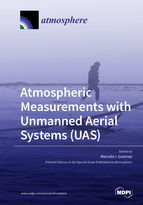Atmospheric Measurements with Unmanned Aerial Systems (UAS)
A special issue of Atmosphere (ISSN 2073-4433). This special issue belongs to the section "Atmospheric Techniques, Instruments, and Modeling".
Deadline for manuscript submissions: closed (28 February 2018) | Viewed by 97620
Special Issue Editor
Interests: environmental photochemistry; interfacial oxidations; environmental monitoring; prebiotic chemistry; photocatalytic CO2 reduction; environmental chemistry
Special Issues, Collections and Topics in MDPI journals
Special Issue Information
Dear Colleagues,
This Special Issue of Atmosphere focuses on the development and implementation of unmanned aircraft systems (UAS) and their integration with sensors for atmospheric measurements on Earth. Articles that combine chemical, physical and meteorological measurements performed in recent field campaigns will be given priority. This includes the development of platform and autonomous systems in laboratories as well as the environmental deployment and operations of such systems. The operation of sensors and remote imaging for weather sensing is of special interest to this issue. While broad in scope, the manuscripts are expected to report the operation of UAS platforms with onboard systems that provide useful atmospheric data. The vision of this Special Issue is to provide a collection of articles to guide future research and motivate measurements that will increase our understanding of Earth’s complex atmosphere.
Dr. Marcelo I. Guzman
Guest Editor
Manuscript Submission Information
Manuscripts should be submitted online at www.mdpi.com by registering and logging in to this website. Once you are registered, click here to go to the submission form. Manuscripts can be submitted until the deadline. All submissions that pass pre-check are peer-reviewed. Accepted papers will be published continuously in the journal (as soon as accepted) and will be listed together on the special issue website. Research articles, review articles as well as short communications are invited. For planned papers, a title and short abstract (about 100 words) can be sent to the Editorial Office for announcement on this website.
Submitted manuscripts should not have been published previously, nor be under consideration for publication elsewhere (except conference proceedings papers). All manuscripts are thoroughly refereed through a single-blind peer-review process. A guide for authors and other relevant information for submission of manuscripts is available on the Instructions for Authors page. Atmosphere is an international peer-reviewed open access monthly journal published by MDPI.
Please visit the Instructions for Authors page before submitting a manuscript. The Article Processing Charge (APC) for publication in this open access journal is 2400 CHF (Swiss Francs). Submitted papers should be well formatted and use good English. Authors may use MDPI's English editing service prior to publication or during author revisions.
Keywords
-
atmospheric Chemistry
-
atmospheric Physics
-
atmospheric Science
-
climate
-
sensors
-
unmanned aerial vehicles
-
weather predictions






